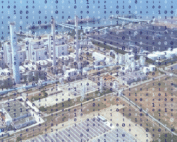When data is distributed across a system, integrating the data into a centralized data system can improve data usage and insights. If you’re implementing a data platform at your site, here is the journey a waste treatment plant took from siloed data to integrated data insights.
Before Implementing a Data Historian at Waste Treatment Plant
For over 20 years, a waste treatment organization has been incinerating and burying waste and supplying steam to neighboring companies. Steam is a byproduct of their operations, incinerating waste from landfills. To improve their incineration processes and provide better services to their steam customers, the organization installed HanPrism, our industrial big data platform, at one of its operating plants.
Need: Chemical Usage Analysis and Unit Management
Waste treatment plants generally use chemicals to remove air pollutants during the waste incineration process. A waste treatment plant must then manage all the hazardous substances generated during the process, the byproduct of which depends on the type of waste incinerated. As a result, the chemicals and amount used vary. The site must ensure they follow the chemical emission standards set by the government.
Before the introduction of HanPrism, the organization drafted reports by hand regularly after collecting chemical usage and facility data. Headquarters had no choice but to rely on the information shared from the site with no method to validate the accuracy or reliability of the data. As a result, the waste treatment organization needed a solution that enabled real-time chemical usage monitoring and reliable data-based report generation for improved information sharing.
Need: Centralization of Facility Data Usage
Like any plant, a waste treatment plant generates data from its equipment and process. Analyzing this data generated at the site plays a significant role when making decisions for efficient equipment operations. By analyzing both historical and real-time data, a site can reduce unnecessary resource waste and improve plant performance.
Before implementing a data historian, the organization performed process monitoring through its PLC control screens. This gave limited access and visualizations and made it nearly impossible for non-operators to access and use the data in real-time. The waste site needed a solution that would support analysis from an enterprise-wide perspective by integrating all data generated at their industrial sites. With an integrated data platform, the waste treatment facility would improve its decision-making process through objective, data-informed insights, and reports.
After Implementing a Data Historian at a Waste Treatment Plant
Benefit 1: Convenient Facility Status Monitoring
It is no longer difficult to access the data when and where they need it. The organization conveniently monitors the facility status by displaying trends and process screens at the site and headquarters. With HanPrism’s web-based process screens, the site monitors their systems from anywhere and at any time, sharing information across and between its three shifts. For example, the site uses HanPrism to share issues and alarms as memos for improved monitoring. By using one system the site increased the efficiency and accuracy of information sharing among all shift members.
Benefit 2: Enterprise-Wide Communication with Data
HanPrism makes it easy to use and share data throughout the organization by integrating all data generated in the field into one centralized system. Real-time condition monitoring is now possible directly at the headquarters, eliminating the reliance on sharing data through periodic reports. This increased communication between the headquarters and sites has enabled the development of practical strategies to improve their operations.
Benefit 3: Report Creation and Automation
The site has automated its report creation and does not have to rely on manual reports with HanPrism. They automatically measure and record weekly chemical usage and generate reports detailing the cost of the chemical usage and performance according to hazardous substance emission standards. This automated process not only saves time but also ensures better accuracy and reliability. By generating reports from data automatically sent from the control system instead of human-centered points, the organization saw a decrease in data errors and an increase in overall data reliability and accuracy.
Benefit 4: Cost Reductions through Data Monitoring
After switching to a data-based plant operating environment, the waste treatment site actively uses data to optimize chemical usage and subsequently reduce costs. For example, when automated reports show chemical usage exceeding the expected amount, the site inspects the equipment to identify areas for improvement and replacement. This not only reduces costs but prevents harmful amounts of emissions from being released into the community.
Next Steps
Centralize your data and get the most value from it with our help. Find out how our customers optimize their data utilization and asset performance management by contacting us today.
HanAra Success Stories
Upgraded Historian to Create an Advanced Data Foundation
Korea Energy (KOEN) provides South Korea with a stable and economical power supply. Through its use of advanced technology, KOEN serves as an example of the power of combining operational and technological expertise. With [...]
Improved Data Usage with HanPrism
NUR Power is Malaysia's first independent power utility. The NUR Power Group owns, operates, and maintains a 220-MW combined-cycle gas turbine plant in the 115-acre Kulim Hi-Tech Industrial Park (KHTP), Malaysia’s [...]
Safe and Efficient Plant Operation with HanPHI
Safety and Efficiency KHNP is the largest Korean electric power company, generating approximately 31.5% of the total generated electric power in Korea. KHNP operates 82 units that include thermal, solar, hydro, [...]



